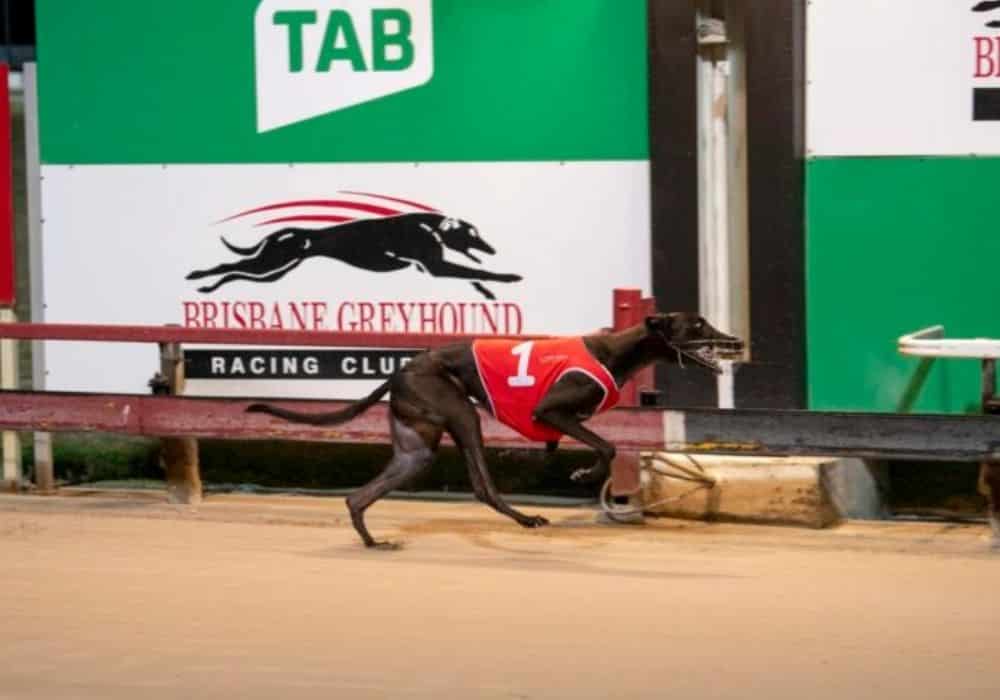
Caption: I can make a proud boast that I have never had a dog that didn’t win. Here is Banjo’s Issue winning at Albion Park (Photo: Box 1 Photography)
By MAX WELLS
I READ with great interest in the July edition of Chase Magazine the ‘empire’ of greyhound training Mark and Lisa Delbridge have in Victoria and can only imagine what the empire of the Dailly kennel is like.
They must be an absolute hive of activity with dogs everywhere, helping hands all making each operation run like clockwork in the bid for a winner.
So, when Chase Newspaper asked me to relate what the other extreme is, I was happy to give them my thoughts on how we operate … with a kennel maximum of THREE!
I am 81 and have been training greyhounds for decades. I came into this industry off a stint as an owner of thoroughbreds. All I got from thoroughbreds was a couple of winners and lots of bills.
I can make a proud boast that in all those decades since I first got into greyhound racing, I have never had a dog we did not win with.
If anyone asks me about getting into greyhound racing, it is always my first advice is to buy a pup.
Newcomers should first get some knowledge about bloodlines, familiarise themselves with the names in pedigrees so they can make a judgement on what is for sale.
I like to suggest this, because newcomers can get a pup reared like I do, bring it home at 10 months, start working with it, walking the streets and letting both you and the dog get to know each other and the routine.
Break it in and then start the training process.
I NEVER suggest buying tried dogs. It is my belief the only reason these dogs are for sale is they have problems and no one should buy a problem dog. That is why they are for sale.
The Ipswich Auction is a very good place to buy pups. Some great dogs have come out of that auction. Obviously, all this depends on your budget.
There are always leading breeders, like Tony Apap, and many of the top trainers, who have well bred pups for sale at all ages.
Buying pups, of course, is a raffle like anything else in the racing game.
I was lucky to buy my first greyhound from experienced breeders and racing as Valkarle she won five races and was placed 28 times. She would not win unless she had box one.
It was a learning process in those days and my suggestion to newcomers is that this is the greatest time to learn training. You learn through your eyes, watching how the best trainers do things.
In all those decades since I first started, nothing has changed much to my training routine.
I still get out of bed at 5am in summer and 6am in winter to walk for 20 minutes and then again in the afternoon for the same time.
By 12 months, those young pups are ready to do a bit of pre-education with a slip up the straight a few times. I always break in my pups at 14 months and this is where I differ from a lot of people. I take no notice of the break-in times. To me, they mean nothing. The main thing is they have to be chasing when they come home from the month’s course.
After a spell, it will take eight to 10 weeks to get the dog close to racing.
My feeding routine has not changed either in all these years. Meat and kibble is the basis, but I’m big on feeding things like beetroot, tomatoes, apples alternating them each day. That old saying an apple a day keeps the doctor away is right for dogs as well.
I toss in glucose, calcium, Sprint Oil and MaxRBC.
Every two weeks I get Pat Dennis to check over my dogs for any muscle problems. He’s been doing that for years.
What do newcomers do wrong?
Each and every one of those newcomers will learn after a while that patience in this industry is everything. Newcomers always go off too early.
Getting the dog to its right weight is imperative and you will notice that when the weight is right, the clock will show it.
My training these days is to concentrate on walks, morning and night, with one hard gallop in between races, always at the Lawnton straight track.
Greyhounds are keeping me alive at 81.
My grandson Adam has become involved in the ownership of the dogs I train and that gives me a great thrill.
I still make sure the dogs are let out at 10pm each night.
We live here on a house block on the Redcliffe Peninsula and have a good-sized block where the dogs can laze around during the day. It’s all I need for one person training a small kennel.
Most of my racing these days is at Albion Park and I’ve never been a fan of straight track racing at Capalaba although I can see why it has become more popular with the prizemoney available.
With the price of trials these days, I can also understand why many trainers are racing their dogs twice a week.
The prizemoney today is getting really good and the rebate scheme in operation is great as well. There is much more breeding happening and obviously the prizemoney and rebate attraction is strong.
Greyhound racing is a wonderful past-time and the dogs make beautiful pets when they have finished racing. Any newcomers to this industry will soon find out that.









